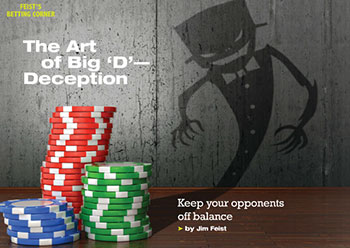THE ART OF BIG ‘D’— DECEPTION
Keep your opponents off balance
By Jim Feist
 Deception is perceived as a bad word throughout most of culture, but there are times when it is an important element to winning – and winning honestly. In warfare, deception is essential to victory on the battlefield, which can help preserve a nation. In sports, some of the best football and basketball coaches utilize deception through trick plays to throw off the opposition, all within the legal rules of the game.
Deception is perceived as a bad word throughout most of culture, but there are times when it is an important element to winning – and winning honestly. In warfare, deception is essential to victory on the battlefield, which can help preserve a nation. In sports, some of the best football and basketball coaches utilize deception through trick plays to throw off the opposition, all within the legal rules of the game.
As a longtime poker player who also studies and wagers on sports on a regular basis, I understand the art of deception. Dallas Cowboy great Tom Landry used to have his tight end come to the line of scrimmage on one side, then when the quarterback hollered “set” to get his linemen into position, the tight end would quickly head over to the opposite side of the line, either to double team a talented pass rusher or as an extra blocker on a run heading his way.
Wide receivers move their head on a cut in one direction, and then zip back instantly the other way. Linebackers and safeties will often walk up to the line showing blitz, then pull back into pass coverage the moment the football is snapped. All these things are meant to confuse the other player or team.
Poker offers endless examples of deception, though not by moving around the table like athletes. Rather, poker is a game of mathematics, skill and psychology. You don’t sit back and wait for the best hand – because many times you’ll be waiting a long time. The best players use all the weapons in their arsenal.
Three key psychological weapons in poker are bluffing, semi-bluffing, and slow playing. All are centered around the fine art of deception. Bluffing can take many forms. You can pretend to be cautious even though you have an exceptional hand, or you can come out firing away with a less than ideal hand, all with the intent to deceive opponents.
Bluffing is more useful in a no-limit game than in a limit game. In a no-limit game, a player’s entire stack is at risk with each hand, while in a limit game, players know they can only lose so much if they call. It’s best to utilize bluffing as a weapon in high-limit games. For instance, betting at the flop with a high card on the board puts it in the minds of your opponents you already have a pair, or raising with a flush draw implies you might be in line for a potential pot-busting flush.
Semi-bluffing is used in sports by coaches and players. A basketball player can make a cut in an attempt to draw a double team freeing the ball handler to exploit somewhere else on the court or make a pass to an open man.
At the poker tables, semi-bluffing is bluffing when you are close to having a great hand, but not all the way there yet. For example, you ante up when you have one or more cards from being a straight, a flush or a straight flush, also known as a drawing hand. If you wager with this hand, you are bluffing, but you also have a respectable probability of gaining a strong hand on later betting rounds. Semi-bluffing is an effective technique, especially in no-limit games.
Slow playing is when the cards that are shown aren’t exceptional, but you hold an outstanding hand, such as two kings or a pair of aces. Your intent at this point is to trick the opponents into thinking you have something unremarkable, when you’re actually sitting on a very strong hand. The purpose at first is you don’t want to scare anyone out. It’s all about building up the pot and knowing the odds are very much in your favor based on the cards you already see.
The difference between sports and poker is that in sports, coaches can plan weeks in advance when they will utilize deception. But there’s only so much planning you can do at the poker table. It’s essential to make so many of your decisions as you are playing, which requires quick thinking and being flexible. And this comes through trial and error, so don’t be afraid to attack the tables with confidence. Taking your lumps and making mistakes is actually a good thing, as long as you file them away and learn each lesson. All of this begets winning – and turning a consistent profit – over the long haul.


